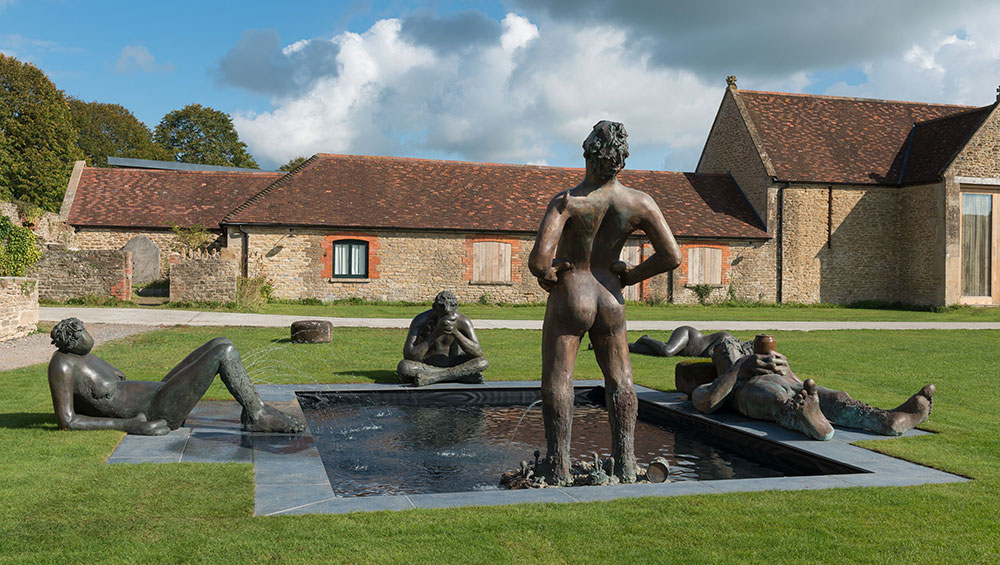
Nicole Eisenman, Fountain, 2017, installation view, Hauser & Wirth Somerset 2020. © Nicole Eisenman. Courtesy the artist and Hauser & Wirth. Photo: Ken Adlard.
Hauser & Wirth Somerset
3 October 2020 – 10 January 2021 (In accordance with recent government guidance, our Somerset galleries are temporarily closed.)
by VERONICA SIMPSON
Nicole Eisenman (b1965, Verdun, France) was already a leading American figurative painter when, in 2012, a month’s residency at Studio Voltaire in London brought her talents as a sculptor to the fore. The resulting show was a revelation for her, as well as the audience: the directness of working by hand to sculpt and shape her plaster figures, she felt, brought a fluency and immediacy that the often repetitive, painstaking work of painting precludes. She said at the time: “I’m thinking about touch and desire as I’m making the work. The way the material feels, the temperature of the body, the delicacy and strength … There is something very sensuous about this material, these bodies, the act of rubbing and the visceral sexiness of touch and texture combined with the weight of the plaster and the mysterious heat it generates.”
.jpg)
Nicole Eisenman, Fountain, 2017, installation view, Hauser & Wirth Somerset 2020. © Nicole Eisenman. Courtesy the artist and Hauser & Wirth. Photo: Ken Adlard.
That sensuality, immediacy, wit and pathos – as well as some of the poses - from those early sculptural experiments are very much present in the figures that comprise Sketch for a Fountain (2017), seen for the first time in the UK here at Hauser & Wirth Somerset. Which is not surprising, as Sketch for a Fountain was conceived soon after that Studio Voltaire experiment, even if it took another five years to emerge in its final form, at Skulptur Projekte Münster 2017, in five bronze and plaster figures. This is the finished work, all in bronze, recently acquired by the Nasher Sculpture Center in Dallas, and rearranged around a newly dug oblong pond in front of the Somerset gallery’s antique brick buildings. Apparently inspired by Paul Cézanne’s Bathers, the work is about communion with nature, about everyday humans in poses of rest and relaxation, with commonplace props.
.jpg)
Nicole Eisenman, Fountain, 2017, installation view, Hauser & Wirth Somerset 2020. © Nicole Eisenman. Courtesy the artist and Hauser & Wirth. Photo: Ken Adlard.
There is something cartoonishly endearing about the figures’ thick, un-muscular torsos, something clownish about their oversized feet. Eisenman likes to challenge classical representation of the body, as well as notions of gender. She calls these figures “guys”, but they are gender-fluid. Appendages are only hinted at, though vigorous curls of body hair erupt from calves and occasionally crotches and armpits. This is no heroic grouping of the usual kind that adorns important buildings or public squares. Water dribbles out of a drinks can that one of the supine figures holds upright on its belly, and spurts from the calves of the seated figure opposite.
During a speech she made at the installation of this work in 2019 at the Nasher Sculpture Center, Eisenman talked of her desire to disrupt the formal expectations around bronze: “The feeling about bronze is it’s such a staid material, so steeped in history that you have to really push the material to make it do something that feels contemporary, otherwise your piece feels like a big tchotchke.” I think we can agree she has succeeded here.
Meanwhile, in the first of the two galleries dedicated to her work is the output resulting from another residency: a two-year stint at the not-for-profit Dieu Donné workshop in Brooklyn, where Eisenman lives. Here, she has collaborated with the workshop’s master papermakers to perfect a style of paper pulp drawing that blends elements of sculpture, painting and collage. Each work entails the painting of pigmented linen pulp on to a cotton substrate as part of the papermaking process. The pulp is then drained and dried to reveal images that have been embedded into the paper to create a kind of two-dimensional sculpture. The topics follow her customary preoccupations - anxieties about our relationship with nature and our increasing dependence on technology.
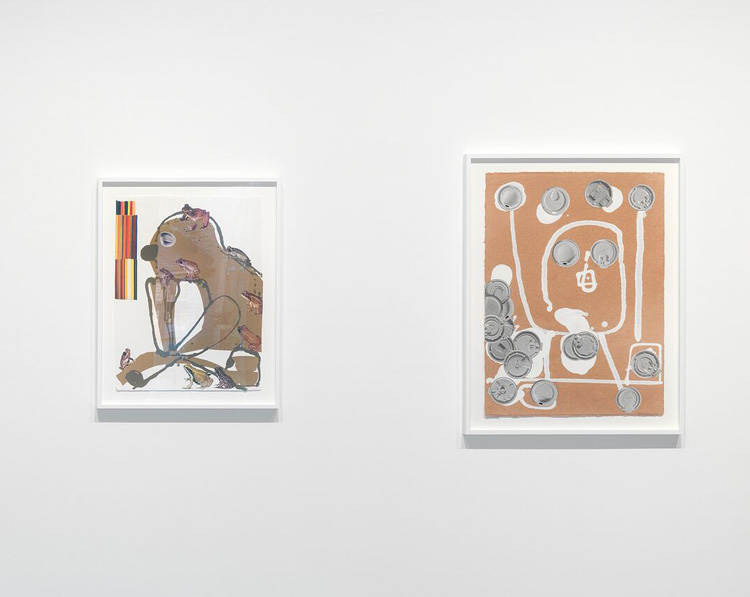
Nicole Eisenman. Left: Untitled, 2020, paper and collage, 62.2 x 47.6 cm (24 1/2 x 18 3/4 in); Right: Untitled, 2018, paper and collage, 77.5 x 57.2 cm (30 1/2 x 22 1/2 in). Photo courtesy Hauser & Wirth.
The resulting works have a strong, graphic quality, their lines an almost three-dimensional depth of tone, and she has dubbed them “posters”, although only a few of them appear overtly poster-ish, using script together with her wry characterisation of plants, animals or people. I liked one animal work in particular: a glowing, green piece (Change, 2020) that hangs in the vestibule between these two galleries, comprising a large, writhing snake that is clearly winking at us, over the word Change; is the snake being ironic, sarcastic, seductive, playful? Probably all of the above.
Of the nature-focused works, I enjoyed the strange, multi-limbed machine marching over a field, its metallic limbs adorned with plastic coffee cup lids (Untitled, 2018); more hilarious was the plant whose multiple blooms appear to be cut-out photographs of rectal fissures (Untitled 2020).
But, to me, the most exciting of these paper pulp drawings were her human figures, “portraits” that seem to contain a similar urgent, anxious vitality to the busts she exhibited in the Arsenale at the Venice Biennale last year, whose jagged, metallic heads, their surfaces scratched and scarred, their eyes staring holes, articulated so much of the prevailing state of contemporary anxiety and disconnect.
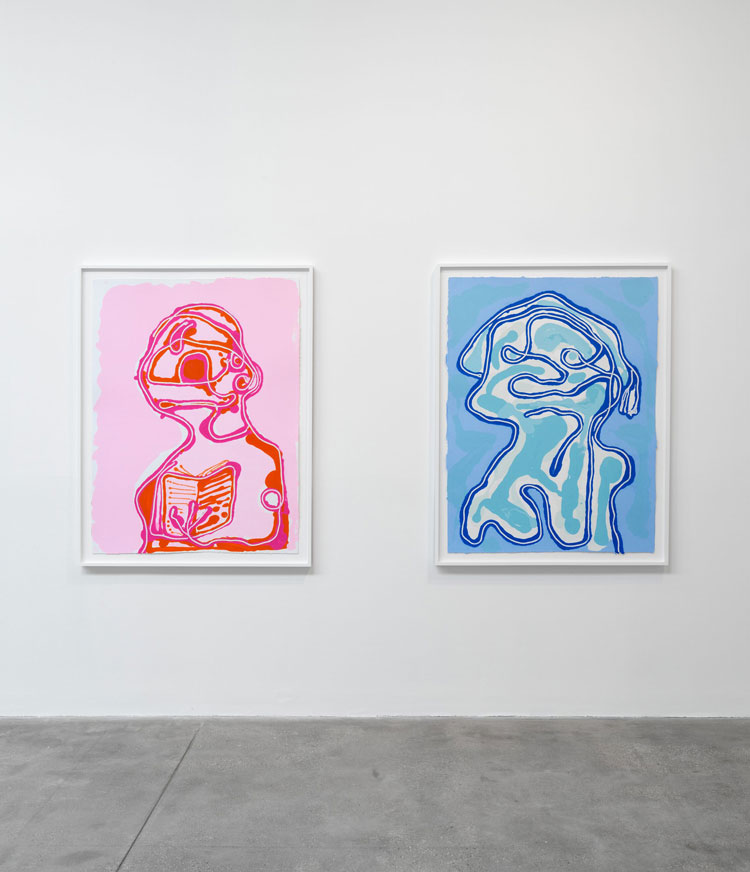
Nicole Eisenman. Left: Untitled, 2019, paper, 135.9 x 101 cm (53 1/2 x 39 3/4 in); Untitled, 2019, paper, 135.9 x 101 cm (53 1/2 x 39 3/4 in). Photo courtesy Hauser & Wirth.
There, it was fascinating the degree to which a mess of metal can represent something so recognisably human. Here, that skill is demonstrated in her rebellious lines: in pushing the limits of representation, she is articulating so much more than a mark weighted down by the need for precision. I stand and marvel at the pink and blue figures paired on the far wall (both Untitled 2019). The pink one does not even appear to have eyes, and the squiggles filling the area where the head should be are in no way recognisable as a face, but it has a neck, and there is clearly a book being held up by a three-fingered hand. It has a strong, startling presence. The blue squiggle to its right does have two loops that could be mistaken for eyes. But their off-centre arrangement conveys a deranged quality.
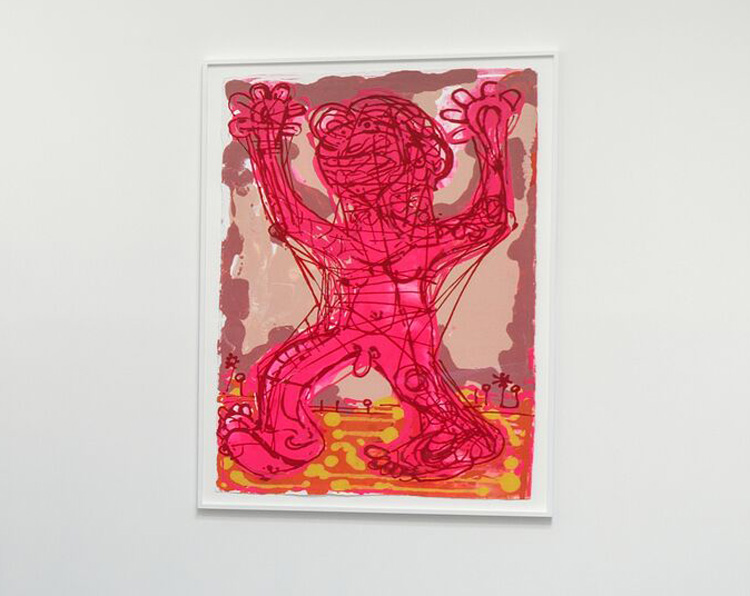
Nicole Eisenman, Untitled, 2019. Paper, 153 x 101.6 cm (60 1/4 x 40 in). Photo courtesy Hauser & Wirth.
It is as if these representations – whoever they are – go beyond the banal features on which we hang so much of our self-esteem or identity, burrowing beneath the skin to the connective tissue in which emotion and tension are held. This raw quality is conveyed most powerfully by the hot, pink mess of a figure on the adjacent wall (Untitled 2019): a hermaphroditic character with boobs, drooping belly and penis, its head and torso are a frantic choreography of knotted lines, its limbs tangled up in threads. It looks like emotionally flayed feels. I am sure we have all had days like these – especially over the last few months.
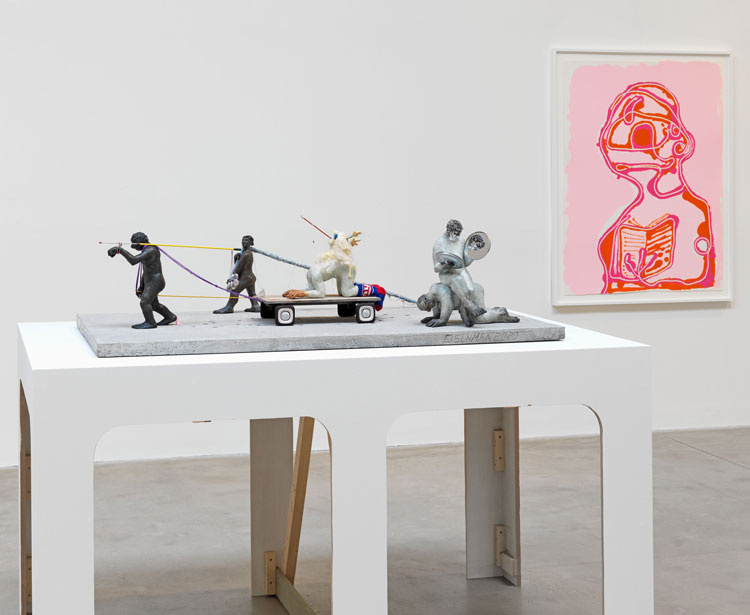
Nicole Eisenman, Procession Maquette, 2020. Bronze, mixed media. Perpetual Motion Machine, 13.5 x 7.5 x. 18 in; Pole Bearer, 10.5 x 34 x 4 in; Eagle in box, 3 x 3 x 2.5 in; Man at the Center of Men, 13.5 x 13 x 9.5 in; Museum Piece con Gas, 14 x 17 x 10 in; Base, 1.5 x 33 x 57 in, concrete.
The (off) centrepiece of this main room is a rudimentary plinth, bearing a delightful maquette of the work Procession, whose realised version Eisenman unveiled at the Whitney Biennial in 2019. She apparently liked the look of her rudimentary, studio mockups so much that she went back to create this finished mini version (Procession Maquette, 2020). She was still working out what this piece meant, she said at the aforementioned Nasher lecture: “It was born out of an idea of togetherness and community and walking together and what that means to me. It’s not something that just popped up, but it has some deeper roots in my practice.”
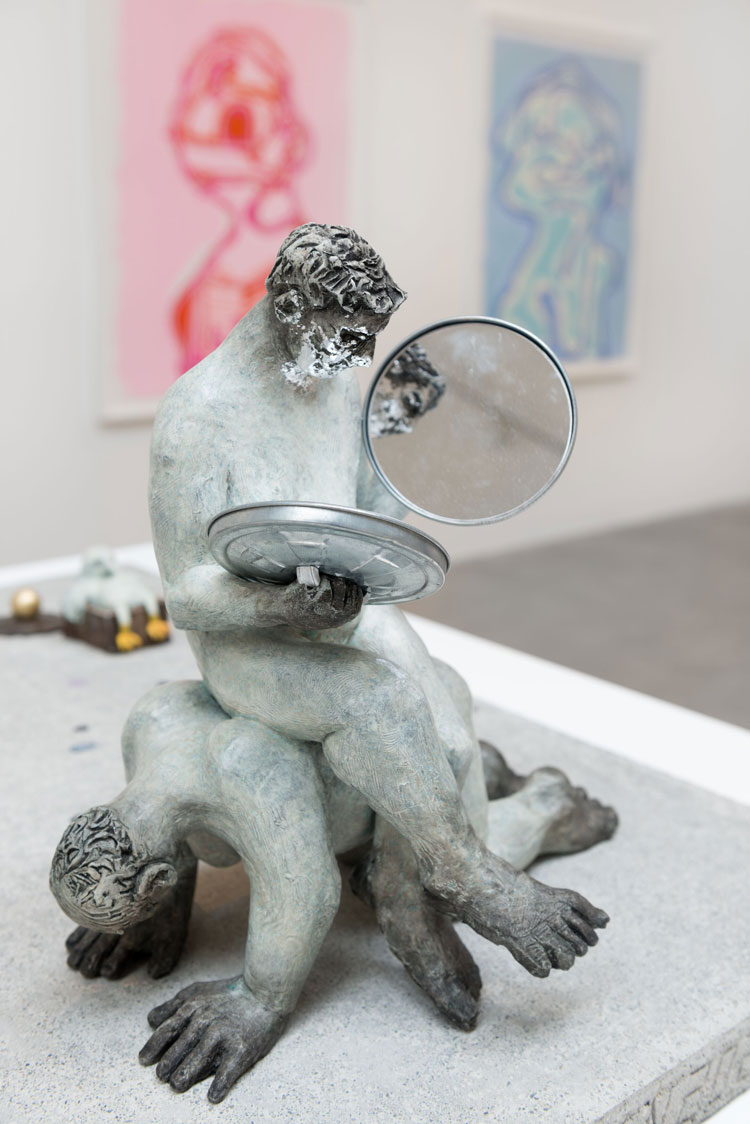
Nicole Eisenman, Procession Maquette, 2020 (detail). Photo courtesy Hauser & Wirth.
In miniature, the figures are massively endearing, and vulnerable, engaged in their seemingly pointless parade. In the coupled figure where one “guy” sits on top of another, who is on all fours, I was drawn to the rough, dark, matte texture of the subservient figure’s feet, in contrast to the gloss of their grey bodies. The seated figure is holding up two dustbin lids, with mirrored insides, just like in the large, Whitney presentation. But there, these mirrors were intended to capture sunlight at a certain point in the day and reflect it, in dazzling sliver “flame”, off the characters silver-coated face. Despite the lack of those solar pyrotechnics, it still serves as a wry reflection on vanity and submission.
In the Nasher lecture, Eisenman says: “I always think of painting as being from the neck up and sculpture as being from the neck down. There’s this tool in between you and the work when you’re painting. It’s like a leap of faith. You’re having to use your imagination when you look at a painting, whereas with sculpture there’s none of that kind of trickery – it is what it is. There’s no sense of removal like when you’re processing an image.”
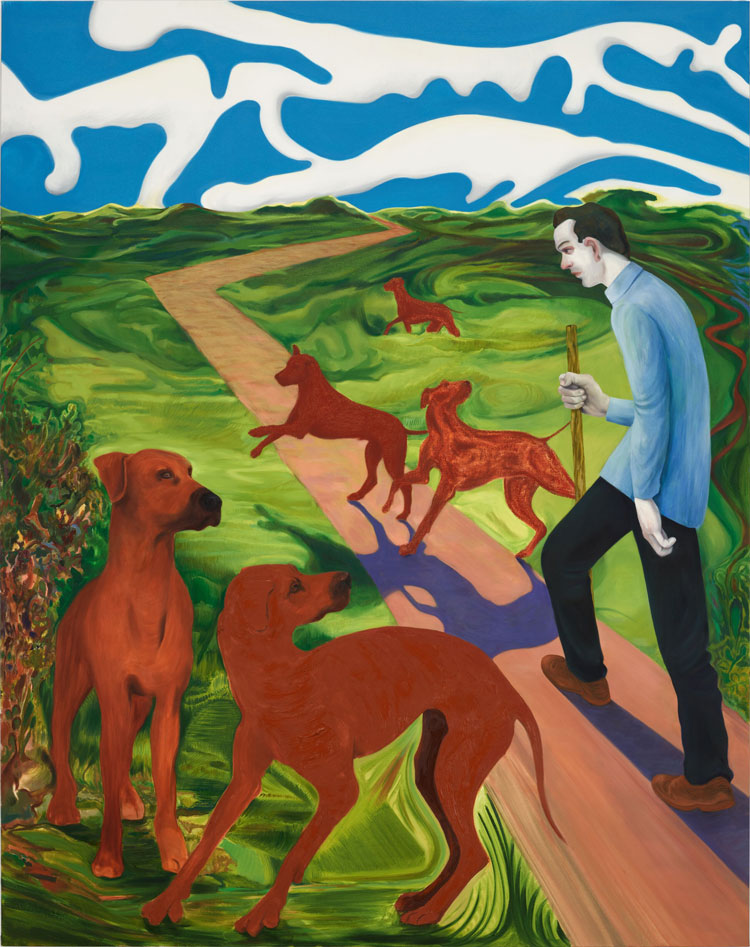
Nicole Eisenman, Where I Was, It Shall Be, 2020. Oil on canvas, 165.1 x 208.3 cm (65 x 82 in). Photo: Thomas Barratt. © Nicole Eisenman, courtesy the artist and Hauser & Wirth.
There is only one painting in this Eisenman show with which to make the comparison. It is the work from which the show takes its title, a kind of dreamscape of a figure walking their dogs (or perhaps the dogs walking their owner). It plays with scale and detail in ways that mess with your head; the multi-limbed shadow thrown by the group of dogs seems more vivid than the flattened outline of the dogs themselves; the white clouds that billow and dance in the blue sky seem more physically present than the landscape below them. This image takes work to unpack and process.
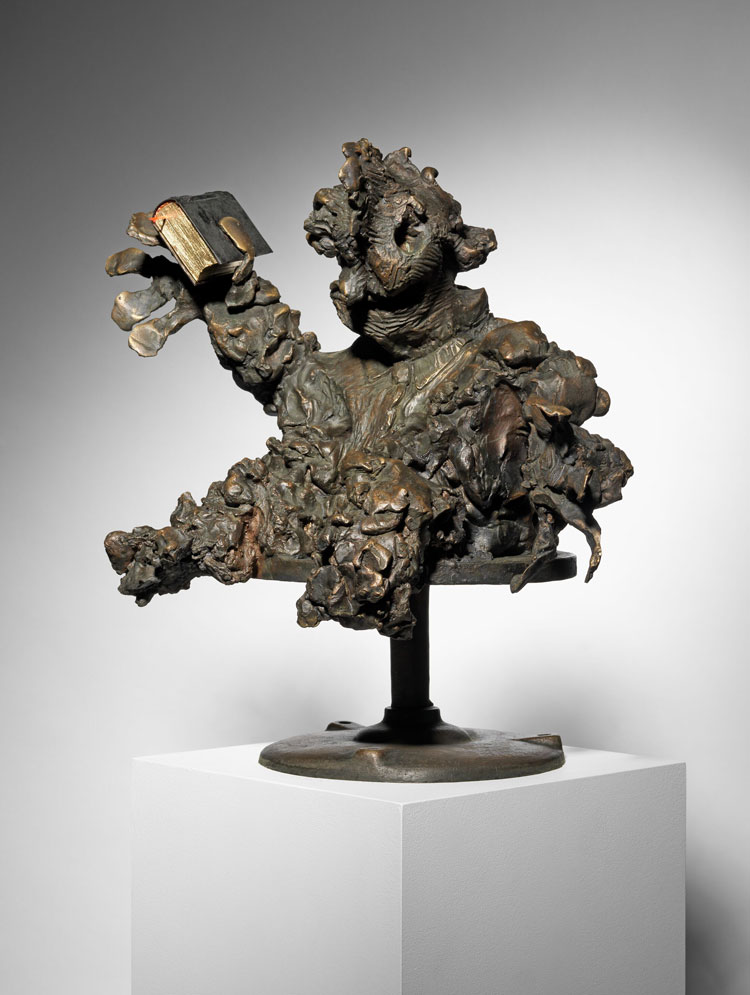
Nicole Eisenman, Goblin, 2020. Bronze, 38.1 x 35.6 x 25.4 cm (15 x 14 x 10 in). Photo courtesy Hauser & Wirth.
There is a far more direct emotional kick to the small sculpture that is positioned a few feet away: Goblin (2020). It is a bristling, angry, demonic figure in bronze, holding a gold-edged book aloft, and was inspired by Trump’s Black Lives Matter stunt from summer 2020, when the police teargassed a protesting BLM crowd so the president could grab a photo-opportunity, raising a Bible in front of St John’s Episcopal church.
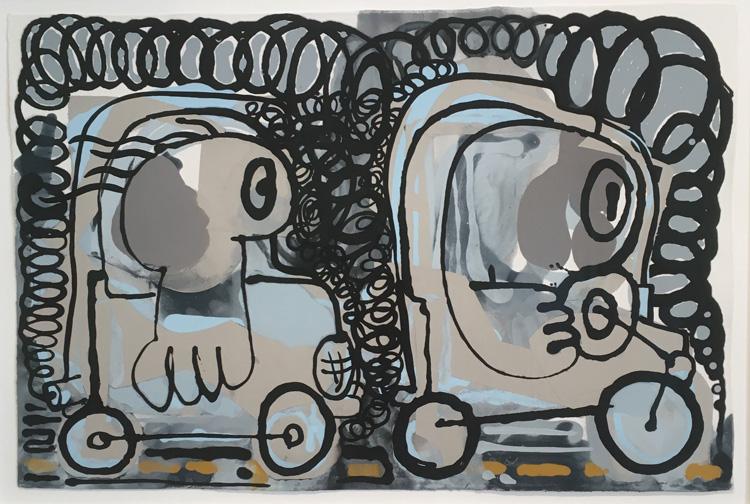
Nicole Eisenman, Untitled, 2019. Paper and ink, 101 x 153 cm (39 3/4 x 60 1/4 in). Installation view. Photo: Veronica Simpson.
Compared with the venom fuelling this overt political statement, the other works in this second gallery seem somewhat of a mixed bag, though I really enjoy the car/human figures near the exit (“car-toons”?) where Eisenman has assimilated the looming figures of drivers into the cramped bodies of their cars, surrounded by billowing clouds of angry, filthy, polluting air.
Plant and animal doodles are all very well, but it is through her figures that Eisenman’s art really hits home. As articulated beautifully in a quote I found on YouTube, from a short clip to celebrate her MacArthur Genius grant in 2015. “I know the world through my body. I understand my desires and my anxieties through my body and the desires and anxieties of our culture. The body can hold so much. It can be a site for just exploring the paint in, or it can hold metaphorical and allegorical meanings. It’s just wide open.”
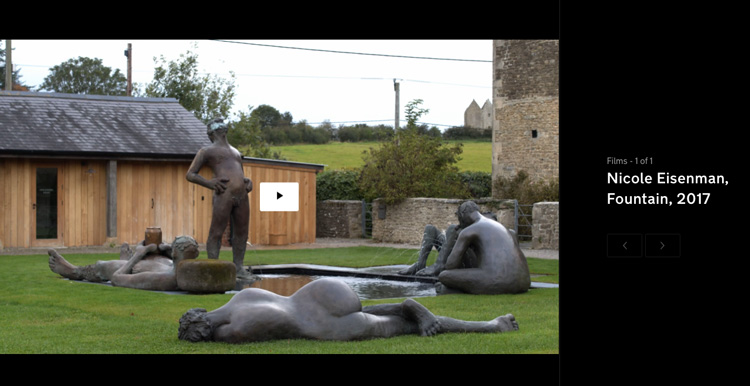
Video of Nicole Eisenman, Fountain, 2017, Hauser & Wirth Somerset 2020.